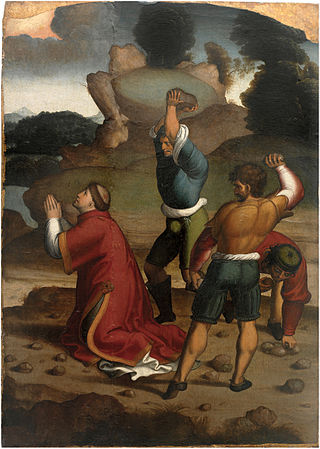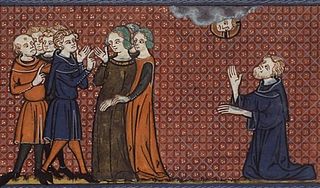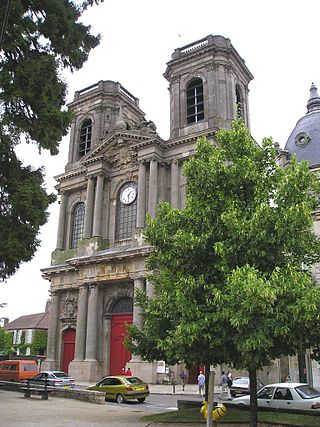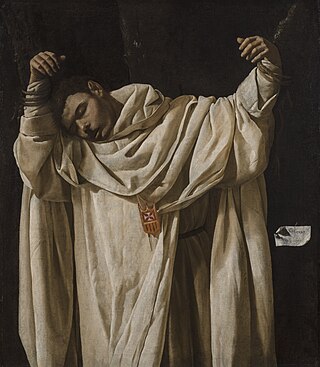
Mark the Evangelist, also known as John Mark or Saint Mark, is the person who is traditionally ascribed to be the author of the Gospel of Mark. Modern Bible scholars have concluded that the Gospel of Mark was written by an anonymous author rather than by Mark. According to Church tradition, Mark founded the episcopal see of Alexandria, which was one of the five most important sees of early Christianity. His feast day is celebrated on April 25, and his symbol is the winged lion.

In Christianity, a martyr is a person considered to have died because of their testimony for Jesus or faith in Jesus. In years of the early church, stories depict this often occurring through death by sawing, stoning, crucifixion, burning at the stake or other forms of torture and capital punishment. The word martyr comes from the Koine word μάρτυς, mártys, which means "witness" or "testimony".

Pelagia, distinguished as Pelagia of Antioch, Pelagia the Penitent, and Pelagia the Harlot, was a Christian saint and hermit in the 4th or 5th century. Her feast day was celebrated on 8 October, originally in common with Saints Pelagia the Virgin and Pelagia of Tarsus. Pelagia died as a result of extreme asceticism, which had emaciated her to the point she could no longer be recognized. According to Orthodox tradition, she was buried in her cell. Upon the discovery that the renowned monk had been a woman, the holy fathers tried to keep it a secret, but the gossip spread and her relics drew pilgrims from as far off as Jericho and the Jordan valley.

Olivia of Palermo, Palermo, 448 – Tunis, 10 June 463, while according to another tradition she is supposed to have lived in the late 9th century AD in the Muslim Emirate of Sicily is a Christian virgin-martyr who was venerated as a local patron saint of Palermo, Sicily, since the Middle Ages, as well as in the Sicilian towns of Monte San Giuliano, Termini Imerese, Alcamo, Pettineo and Cefalù.

Nabor and Felix were Christian martyrs thought to have been killed during the Great Persecution under the Roman emperor Diocletian. A tomb in Milan is believed to contain their relics.

The Roman Catholic Diocese of Langres is a Roman Catholic diocese comprising the département of Haute-Marne in France.

Willibald was an 8th-century bishop of Eichstätt in Bavaria.

The Roman Catholic Diocese of Soissons, Laon, and Saint-Quentin is a diocese of the Latin Church of the Roman Catholic Church in France. The diocese is suffragan to the Archdiocese of Reims and corresponds, with the exception of two hamlets, to the entire Department of Aisne. The current bishop is Renauld Marie François Dupont de Dinechin, appointed on 30 October 2015. In the Diocese of Soissons there is one priest for every 4,648 Catholics.

Saint Aquilinus of Milan, also known as Aquilinus of Cologne, is venerated as a martyr by the Catholic Church.
Saint Philetus is, along with Saints Lydia, Macedo(n), Theoprepius (Theoprepides), Amphilochius and Cronidas (Cronides), venerated as a Christian martyr. Philetus was supposedly "...a senator who resided in the province of Illyria and was put to death during the persecution under Emperor Hadrian]..."

Rictrude was abbess of Marchiennes Abbey, in Flanders. The main early source for her life is the Vita Rictrudis, commissioned by the abbey, and written in 907 by Hucbald.

Saint Ephigenia of Ethiopia or Iphigenia of Ethiopia, also called Iphigenia of Abyssinia, is a folk saint whose life is told in the Golden Legend as a virgin converted to Christianity and then consecrated to God by St. Matthew the Apostle, who was spreading the Gospel to the region of "Ethiopia," which in this case is understood to be located in the regions south of the Caspian Sea, either in one of the provinces of Mesopotamia, or in Ancient Armenia (Colchis).
Flavius Latinus was a Christian martyr of the persecutions of Trajan.

Saint Serapion or The Martyrdom of Saint Serapion is a 1628 oil on canvas painting by the Spanish artist Francisco Zurbarán (1598–1664). The work was commissioned by the Mercedarian Order to hang in the De Profundis hall of their monastery in Seville. Zurbarán is noted for his portrayals of penitent or martyred monks and saints. Critic Tom Lubbock used this painting to illustrate a difference in the way the martyrdom of two different saints were depicted. He contrasted the understated and calm depiction of St. Serapion's violent death, with the equally or more violent death of the Jesuit priest and martyr Saint Edmund Campion (1540–1581) who was publicly hanged, drawn and quartered in London in December 1581. The art critic draws a comparison in the manner of depiction of Campion's death and that of Saint Serapion of Algiers (1179–1240), a Mercedarian friar who fought in the Third Crusade of 1196 and was later martyred.
Saint Euprepius of Verona, is venerated as the first bishop of Verona. Not much is known of his life beyond the fact that his name was Greek, which is considered evidence of the antiquity of the Veronese see.

Saint Paulus of Verdun (576-648) was a bishop of Verdun in the Lorraine region of France from 630 until his death in 647 or 648.
Januarius and Pelagia were joint Christian martyrs and saints recorded in the Jerusalem Martyrology. They were beheaded or racked and torn with iron claws and pieces of earthware at Nicopolis in Armenia during the reign of the Roman emperor Licinius. Their feast day observed on July 11. They are possibly to be considered identical with SS Januarius and Marinus who were martyred in the same place in the same year under identical circumstances with the martyrs Nabor and Felix; their feast day, however, was observed on July 10. Alternatively, the quartet may have been a combination of Januarius and Pelagia with the SS Nabor and Felix were martyred in Italy in the early 4th century.
Felix (d. 303) was a bishop of Thibiuca in Africa who was martyred during the Great Persecution under the Roman emperor Diocletian alongside Audactus, Fortunatus, Januarius, and Septimus. Felix is said to have resisted the command of the local magistrate Magnillian to surrender his church's copies of the Christian scriptures. In one account, Felix and the others were taken to Carthage and decapitated on July 15. These Five Martyrs of Carthage were venerated in the basilica of St Faustus. Another placed his martyrdom at Venosa in Italy. His companions may have been deacons but, apart from their joint martyrdom with Felix, are now unknown. Their feast day was observed jointly on October 24.
Sigrada of Alsace was a Franco-Burgundian countess and mother of Ss. Warin, and Leodegar, and grandmother of St. Leudwinus.













